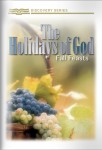Messianic Pictures in the Temple Sacrificial System
There is a unique characteristic in human nature that has acquired a modern tag: closure. There is something in the human psyche that requires a clean, understood, and absolute end to any given event.
“And at the ninth hour, the High Priest would bring closure to the daily sacrifices with the words, ‘It is finished.’ He could then retire to the holy place, bringing holy incense to the altar and watch the smoke ascend. All Israel knew, when the saw the smoke rising up from the Holy Place, that the work was over.”
We are creatures that need to know it’s over. There is nothing else to watch, nothing else to do, no more to be said, it is finished.
Often in our faith walk, we feel like there is something more we should be doing. We find ourselves feeling guilty at times because we have convinced ourselves that somehow, God demands more out of us. We “do” in the hopes of earning the Lord’s favor, but it never seems to be quite enough. Eventually, this results in burned-out Christians who become of no use to the Kingdom. Some even fall away completely, entering into sin and actually working against God.
In the Temple era, if a person had sinned, had become unclean, or simply wanted to say thank you to God, there was the altar and the priesthood. You could bring in your goat, lamb, or pigeon, and go through the ritual. At some point, the sacrifice was made, and according to Scripture, there was closure. You could leave the Temple Mount certain that your prayers had been heard and that you were forgiven, clean, or your thanksgiving received by the Almighty.
And at the ninth hour, the High Priest would bring closure to the daily sacrifices with the words, “It is finished.” He could then retire to the holy place, bringing holy incense to the altar and watch the smoke ascend. All Israel knew, when the saw the smoke rising up from the Holy Place, that the work was over.
We, as believers, must know also that as the Messiah said, “It is finished.” Over several millennia, the Lord of Hosts conceived, and then grew the sacrificial system in a tiny, insignificant country, among an obstinate people insistent on doing things their way, often in a rebellious way. But are we any different?
The groundwork was laid, the foundation put in place, the building built year by year, prophecy by prophecy, until in the fullness of time, the Creator laid aside His glory and became man. He dwelt among us, as a Jew, in the synagogue, in the Temple, among the children of Abraham. He was the Torah, the living Law and the living Word, and the pages of the “Law of Moses and the Prophets and the Psalms” were brought to fruition.
Ultimately, like so many lambs before Him, the Son of God, was “Like a lamb that is led to slaughter, And like a sheep that is silent before its shearers, So He did not open His mouth” (Isaiah 53:7). The pattern had been laid down, the precedent was entrenched. Now it needed closure, both for then and for now.
The Lamb of God was slain. And the One who was without sin, took our sin and proclaimed, “‘It is finished!’ And He bowed His head and gave up His spirit” (John 19:30).
“But Christ being come an high priest of good things to come, by a greater and more perfect tabernacle, not made with hands, that is to say, not of this building; Neither by the blood of goats and calves, but by his own blood he entered in once into the holy place, having obtained eternal redemption for us. For if the blood of bulls and of goats, and the ashes of an heifer sprinkling the unclean, sanctifieth to the purifying of the flesh: How much more shall the blood of Christ, who through the eternal Spirit offered himself without spot to God, purge your conscience from dead works to serve the living God?” (Hebrews 9:11-14)
For you, for me, for all you who believe, there is nothing left to do. There is nothing we can add to or take away from. The work has been accomplished. It is finished.
PR
Notes
All Scripture references are from the New American Standard Bible unless noted otherwise.
1 The Hebrew connotation here is a kippur, a covering similar to that which covers, or atones, for sin. It was a literal covering for their nakedness, but it was also a spiritual kippur, covering their sin.
2 Psalm 44:21
3 Acts 11:9
4 Acts 10:28
5 Acts 15:7-9
6 Acts 15:1
7 Colossians 1:13
8 Colossians 1:22
9 One could not merely come into the Temple to offer an asham sacrifice. If the asham was the goal, all the other, lower order (by comparison) sacrifices were a part of the process. The repentant would have to start with the Burnt offering and work his way up to the Guilt offering. The entire sequence of events was interconnected. The Guilt offering, therefore, assumed all the other offerings as well.
10 Exodus 29:13 , 29:22, Lev 1:8, 1:12, 1:16, 3:3, 3:4, etc.
11 Psalm 51:17
12 Genesis 6:8
13 Genesis 7:2
14 Genesis 22:8
15 Genesis 15:9
16 John 1:1-4
Bibliography
Thus Shalt Thou Serve, by C.W. Slemming (Ft. Washington, PA: Christian Literature Crusade, 1974).
The Temple, by Alfred Edersheim (Grand Rapids: Wm. B. Eerdmans Publishing Company, 1994).
The Mishnah (New York: Judaica Press, Ltd., 1964).
The Torah Club (Jerusalem: First Fruits of Zion, Israel (distribution office: Littleton, CO), 1995).
To learn more about the redemptive pictures and messianic promises inherent in the biblical holidays of Leviticus 23, read these on-line study booklets by Kevin Williams (published by RBC Ministries):
Fall Feasts Rosh Hoshanah, Yom Kippur, TabernaclesSpring Feasts Passover, Unleavened Bread, First Fruits, and Pentecost.
Category: Biblical Studies, Pneuma Review, Spring 1999



